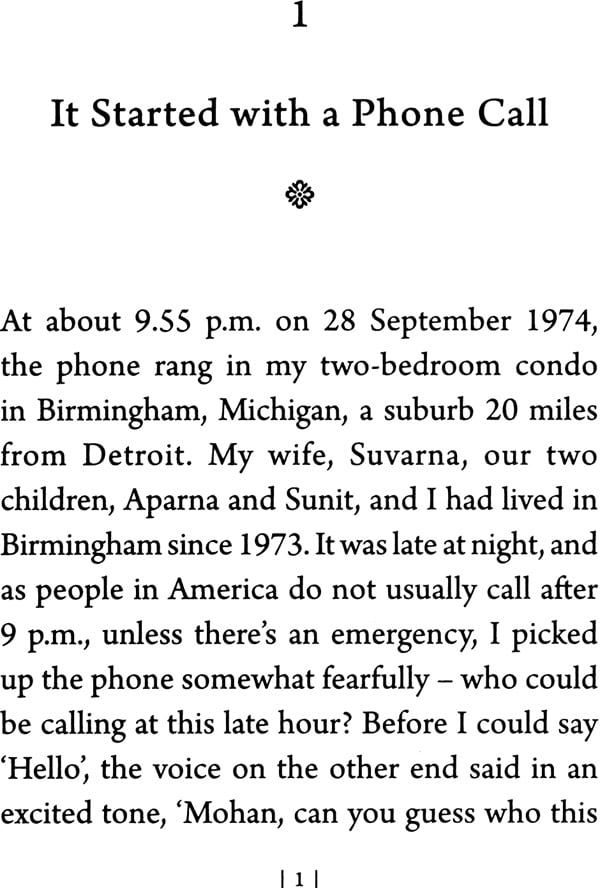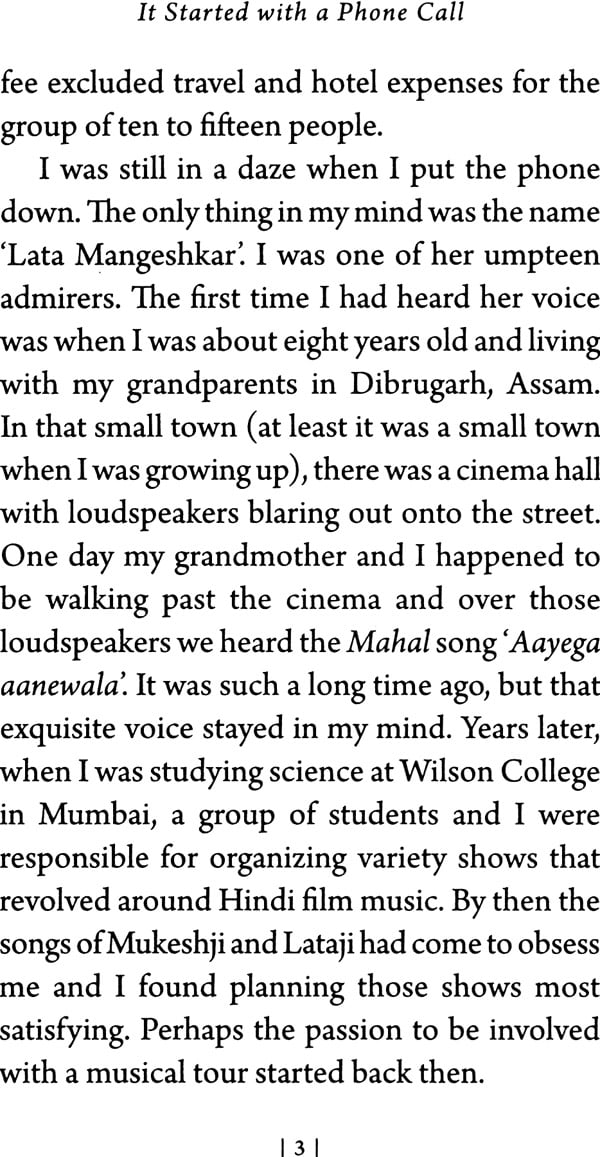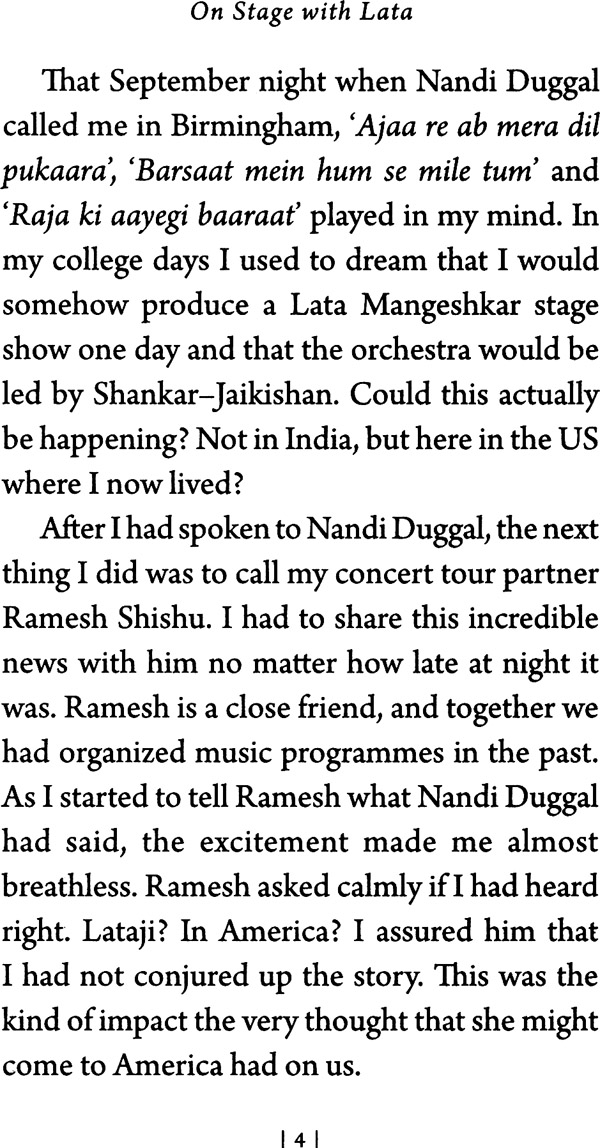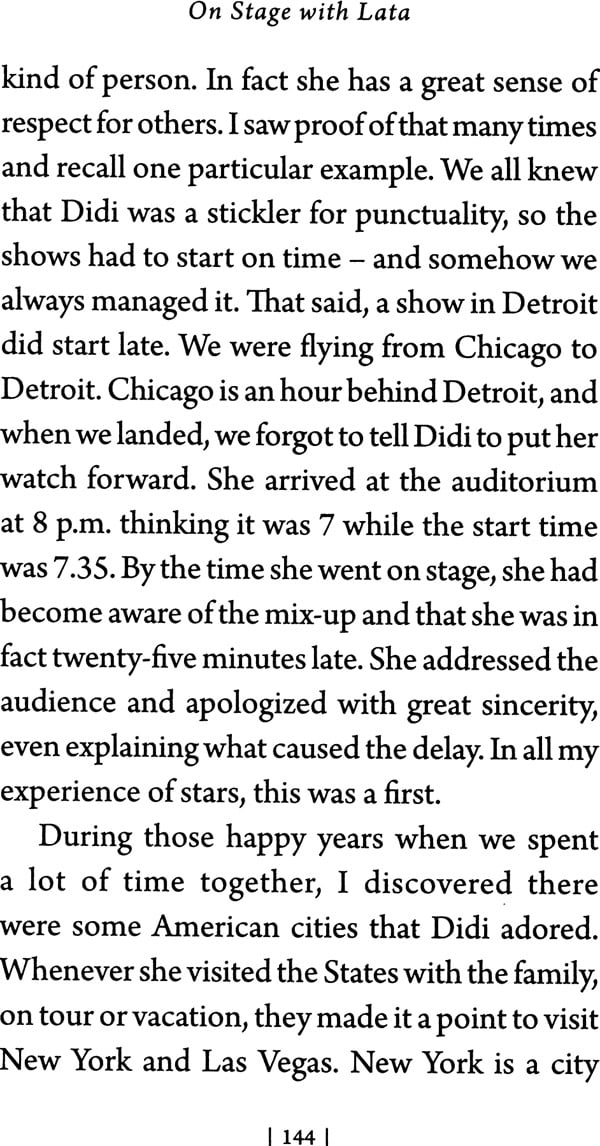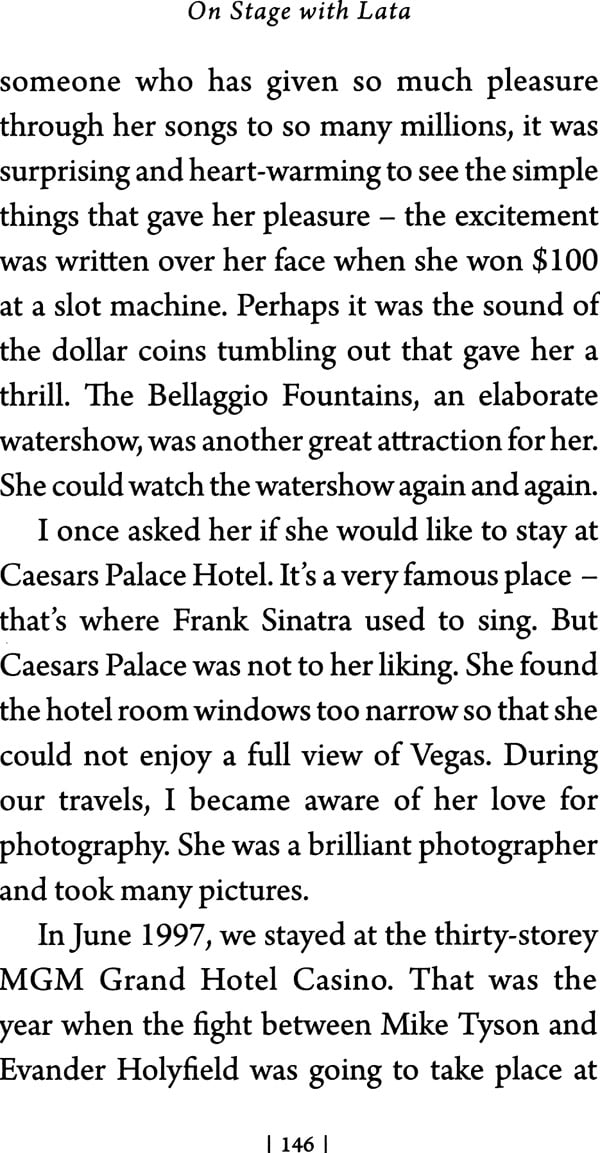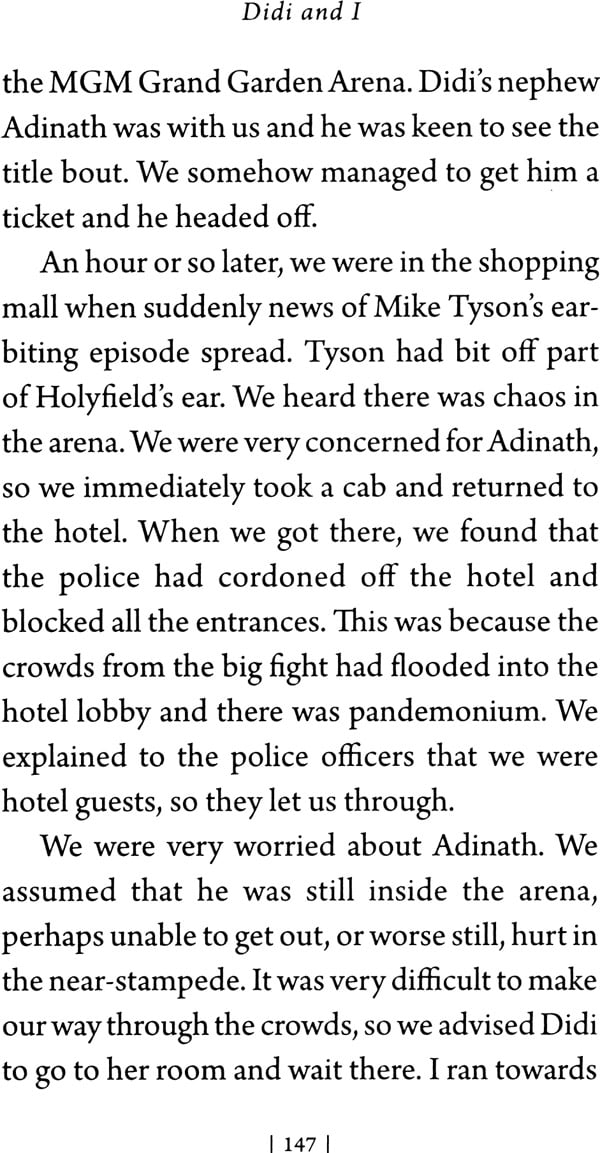
On Stage with Lata
Book Specification
| Item Code: | NAN397 |
| Author: | Nasreen Munni Kabir |
| Publisher: | Harper Collins Publishers |
| Language: | English |
| Edition: | 2017 |
| ISBN: | 9789352643165 |
| Pages: | 219 (45 color & 2 B/W Illustrations) |
| Cover: | Paperback |
| Other Details | 7.5 inch X 5.0 inch |
| Weight | 200 gm |
Book Description
Lata Mangeshkar's life and career are widely known, and yet there is an aspect that remains largely unrecorded: her life on the international stage. Beyond the confines of a recording booth, or as the voice of generations of actresses, she was an accomplished and magnetic performer on stage. She attracted vast audiences of Indian origin who have made their home in many countries, including the US and Canada.
Mangeshkar transformed how the Indian film music concert was perceived in the West by refusing to be part of the low-key song-and-dance performances that were held earlier in community halls, schools and colleges. She insisted that she and her colleagues would sing only in mainstream auditoriums - this was an unheard-of demand because Indian film artistes had never performed on those stages at that time.
In On Stage with Lata, Mohan Deora-co-promoter and co-organizer of Lata Mangeshkar's international tours from 1975 to 1998 - allows us to journey with her and the top male playback singers, including Mukesh (who tragically died during a Detroit tour), Manna Dey and Kishore Kumar. Deora and Shah write about the participation of stars including Amitabh Bachchan and Dilip Kumar, Waheeda Rehman and Farida Jalal. Mangeshkar is described here in her interactions with musicians, colleagues and friends as she meticulously prepared to sing on stage. The tours led to planning and glitches, camaraderie and tension, and anecdotes galore. They also provided the authors with a unique opportunity to observe the clarity of thought with which Lata Mangeshkar approached her work, and to see a great artiste at the height of her powers.
Born in Fatehpur (Shekhawati), Rajasthan, in 1943, Mohan Deora moved to America in 1964. He has a master's degree in chemical engineering and an MBA and has worked for thirty-five years with DTE Energy at their Nuclear Power Plant Fermi- 2. From 1975 to 1998, Deora and his team organized over a hundred path-breaking Lata Mangeshkar concerts in the US, Canada, West Indies and Fiji. He is now retired and lives in Florida.
Born in Mumbai, Rachana Shah was a child singer and performed on stage with her aunt Lata Mangeshkar in various countries. She graduated from St Xavier's College in political science in 1988. She has worked on the Marathi stage and for six years was the media head for the celebrated photographer Gautam Rajadhyaksha. Rachana lives in Mumbai and is married to ENT surgeon Dr Nishit Shah.
Born in India, Nasreen Munni Kabir is a, London-based film-maker and author who has made dozens of documentaries on Hindi cinema and written sixteen books on the subject. Kabir has served a six-year term as governor on the board of the British Film Institute and continues to curate the annual Indian film season on UK's Channel 4 TV.
Different aspects of Lata Mangeshkar's life, her professional career and her social and charitable activities have been the subject of many books and articles. But a feature of her working life that has remained largely undocumented are her international tours and pioneering role in raising the standard of Hindi film music concerts in the West.
I am proud and privileged to say that together with my team, we organized and promoted Lata Mangeshkar's shows in the United States of America, Canada, the Caribbean and the Fiji Islands from 1975 to 1998. The shows were all record-breaking events and had her fans coming in their thousands to see her at every venue and in every city.
Lata Mangeshkar was undoubtedly instrumental in upping the bar of the Hindi film music show outside India. Formerly, singers would perform in low-key song-and-dance events that were held in small community halls, schools and colleges. But Lataji insisted that she and her co-artists would sing in mainstream venues. She was the first Indian singer to take the stage at the Royal Albert Hall in London (1974), and during our US/Canada tours, she sang at the top venues where world-class musicians have performed. These prestigious venues included New York's Carnegie Hall, Madison Square Garden (MSG), Shrine Auditorium Los Angeles [LA], Fox Theater (Detroit) and Maple Leaf Gardens (Toronto).
In late 1974, when I first proposed the idea of touring the USA and Canada to her, she refused. It was only thanks to Mukeshjis gentle persuasion that Lataji finally agreed. From the first tour in 1975, we went onto make musical history for our communities settled in the West.
For many years, I have believed that the experience and memories of those concerts' should be preserved in book form. That said, I was a little nervous when discussing the idea with Lataji, as I did not know how she would react. But when I explained the kind of book I had in mind, she immediately encouraged me by saying that she thought it was an excellent idea. That's all I needed to hear.
It took me about two years to gather the material and images needed for the book. My core team and I spent several hours recollecting memories of those times, reliving those wonderfully special days when we put the shows together. As soon as I had gathered all the material and notes that I had made along the way, I sat down to writing. It was not long before I realized that I needed the help of Rachana Shah, Lataji's niece. Although this book is written entirely in the first person narrative, I would not have been able to complete it without her help. I have known Rachana since she was nine years old, and when I told her that I wanted us to share the author credit, she was reluctant, and said, 'No, Uncle. It is not necessary: But I was adamant.
On Stage with Lata is the result of our collaboration. Through anecdotes and memories, this is an account of Lata Mangeshkar on tour, starting with our first show at the beautiful Shrine Auditorium in Los Angeles on 9 May 1975 when Lataji and Mukeshji topped the bill.
Beyond the confines of a recording booth, or as a voice coming from the lips of generations of screen stars, we discovered a whole other side of Lataji as she performed before her army of adoring fans. Her perfect dedication towards her work, her exchanges with co-singers, musicians and friends provide new insight into a personality whose brilliant songs are etched forever in our hearts. The overwhelming response to Lataji in the Fiji Islands or in the Caribbean came as a surprise even to her - but as always she reacted to the wildly enthusiastic reception she received with great humility.
Over a twenty-three-year period of touring, each set of concerts brought new adventures - it was a very different kind of musical journey for us all. Many things happened along the way, but the most devastating was losing Mukeshji in Detroit in 1976. We could not get over his sad demise.
To organize fifty concerts across the USA and Canada was no simple task. It required detailed planning and commitment. I had my responsibilities to my own professional career as a nuclear power generation specialist, so I needed support from my friends. They had their own day jobs too, but together we somehow accomplished our mission. My core team stood by me through the years and without their help, these concerts would not have happened. It is impossible to list the great number of well-wishers who came forward to solve our problems, but they know that I shall always be in their debt.
In undertaking this book, I have used the generous contributions of many people who were closely associated with me, starting with my 1975 tour partner Ramesh Shishu. I would like to mention the Detroit journalist Usha Mangrulkar who was once a newscaster for the radio programme The Sound of India, and whose long article on the 1975 tour was of immense help to me.
I am very grateful to Nasreen Munni Kabir who has so meticulously edited the text, translated the Hindi passages and helped Rachana and me give the book its final shape. I extend my thanks to my brother Ashok and his wife Alka, Vishakha, Ron Eisenberg, my three grandchildren Ajay, Saaniya, Armaan, and Shantanu Ray Chaudhuri of Harper Collins who have encouraged me all the way.
If I were to thank Lata Mangeshkar for putting her trust in me over all these years, and for all the many things that she has done for me, I am sure this book would double in size. So I will end by saying that there is nothing truer than the simple statement made by my wife Suvarna, my children Aparna and Sunit, and all the people who came forward to help when they said, ‘Anything for Lataji.
One day some concert organizers came to my father and asked if they could hold a jalsa where my father Deenanath Mangeshkar, a celebrated classical singer} would perform. I was standing nearby and overheard the conversation. I said, 'Baba, I want to sing too:
'What will you sing?' he asked.
'You taught me Raga Khambavati, so I'll sing that, and a song from one of your plays:
He looked at me somewhat taken aback - perhaps my confidence took him by surprise. I was only nine years old. My father thought it over for a few minutes and agreed that I could sing with him on the stage.
Later that day, I put on a white frock with tiny patterns on it, styled my hair in a wave across one side of my face, and started to head towards the main door of the house when my mother stopped me and asked where I was going. I didn't answer her and quickly slipped out. There was a photographer's studio across the street from where we lived. I pushed my way in and asked the photographer to take a picture of me. A few days later, it appeared in the local newspaper alongside a photograph of my father, with the caption: 'Classical programme by father and daughter’.
The evening of the concert finally arrived. I was the first to get onto the stage and sang Raga Khambavati. Then my father sang late into the evening. I was very sleepy and put my head on his lap and fell fast asleep. Everyone seemed happy enough about my first public appearance.
My father, who was a very good astrologer, once read my horoscope. He told my mother, 'Lata is a very good singer. You cannot imagine how famous she will become. She will sing but will not marry: His words did come true and music became the centre of my life.
I am sure that performing on the stage at that young age helped me to sing in public. Over the years, I have sung at many concerts in India, especially in Kolkata. We sang in theatres and stadiums. The Bengali audience was fantastic. They listened so attentively. They usually asked me to sing the Bengali songs that I had recorded.
Sometimes strange things would happen at concerts. Someone would come to the green room and ask, 'May I sing in your show?' I would refuse and say, 'If you want to sing, sing for me. If you sing well, you can rehearse and sing on stage. But I cannot just let you start performing in our show without knowing what you can do’. This kind of thing happened in India and even when I performed abroad.
My first concert outside India was in 1974 at the Royal Albert Hall in London. It was a wonderful show. A close friend, S.N. Gourisaria, and the celebrated diplomat and statesman, V.K. Krishna Menon, who had launched the India League in London, organized the show beautifully. Dilip Kumar introduced me in glowing words, but when I stepped onto the stage and faced the audience, I felt a trembling sensation in my throat. I could not utter a sound. I did not know what to do. I knew it was the daunting pressure of getting it right. I somehow sang the opening shloka and by the time I had finished singing, I had become a tigress!
In late 1974, Mukesh Bhaiya came to see me and talked about Mohan Deora who lived in Detroit. He said Mr Deora had organized concerts for him and now wanted to produce a Lata Mangeshkar tour of the US and Canada. I was hesitant about singing in America. In 1969, when I was visiting my close friend Nalini Mhatre who lived in Canada, she thought it would be fun if we went to New York for a few days. In later years, I came to love New York and it became my favourite US city, but at first, I found it scary and intimidating. The hotel where we were staying was very rough: it was not a nice place at all. Rather odd-looking people milled around, and at nights we could hear loud and aggressive banging on the doors. I got scared and told Nalini we should go back to Canada at once. This unfortunate experience coloured my first impression of America.
Mukesh Bhaiya was aware that I was reluctant to perform in the US, but he insisted I should at least meet Mohan Deora. So Mohanji came to Mumbai in December 1974. To be perfectly honest, when I met him I was not sure that he and his team would be able to organize the shows well. That was my first impression. But Mukesh Bhaiya said Mohanji was a very good man and a good organizer. He said he was happy with his US shows and assured me that everything would go well. I thought it over and finally agreed. 'Mukesh Bhaiya, if you come with me, I'll go,' I said.
'Of course I'll come with you. It'll be something new and exciting for the audience there if we went together’.
I was unaware at first that I had in fact a connection to Mohan Deoras family through his wife, Suvarna, whom 1 call Bhabhi. She was the daughter of the very famous director P.L. Santoshi, who also wrote lyrics. Santoshi Saab was very fond of me and once came to me saying that he was planning to make a movie with Madhubala and wanted me to compose the music. He even sent me some lyrics, but 1 explained that 1 had so much work and did not have the time to compose. 1 think the movie was shelved and then 1 believe Madhubala also got busy with another film.
1 did not choose the auditoriums for the US/Canada tours. But 1 did tell Mohanji that considering my first show abroad was at the Royal Albert Hall, we had to find venues of the same calibre. 1 did not want to perform in a community hall or in a school or something. That's where some of the earlier performances of playback singers had taken place abroad.
| Preface | ix | |
| Introduction: Lata Mangeshkar | xvii | |
| 1 | It Started with a Phone Call | 1 |
| 2 | 1975: The Prep, the Arrival | 18 |
| 3 | The Big Night in LA | 35 |
| 4 | The Ground Beneath Us Shook | 48 |
| 5 | Setting the Trend: 1977-80 | 63 |
| 6 | A Promise Fulfilled: 1980-83 | 79 |
| 7 | Conjuring Magic with Lata-Kishore: 1985 | 94 |
| 8 | New Voices: 1987 and 1995 | 116 |
| 9 | The Final Tour: 1998 | 132 |
| 10 | Didi and I | 143 |
| Appendix | 12 |
